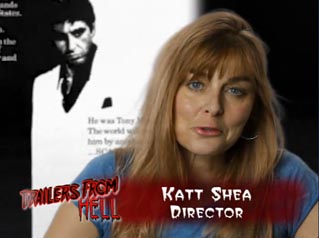TWO CHICAGO INTERVIEWS AS SHE GEARS UP FOR 'A VERY CARRIE CHRISTMAS'
 Piper Laurie is gearing up for her appearance at tomorrow's "A Very Carrie Christmas" at Chicago's Music Box Theatre by doing interviews with Chicago media. A couple of very good interviews have popped up in the past week, including one by Hollywood Chicago's Matt Fagerholm, which includes this section about Laurie's work on Carrie:
Piper Laurie is gearing up for her appearance at tomorrow's "A Very Carrie Christmas" at Chicago's Music Box Theatre by doing interviews with Chicago media. A couple of very good interviews have popped up in the past week, including one by Hollywood Chicago's Matt Fagerholm, which includes this section about Laurie's work on Carrie:HollywoodChicago.com: In the excellent DVD edition of “Carrie,” you mention how your interpretation of the script as satire initially helped you ease into the role of Margaret White. Was satire in your mind while onset?
Laurie: I just tried to get that out of my head. Once De Palma revealed that he didn’t want a satirical approach and said, “You’re going to get a laugh if you do that,” I realized that he didn’t want laughs, at least not in our conscious performing. I just fully embraced the reality of what I was playing. I must say that I enjoyed having the childlike freedom to play act and be the evil witch. It was very freeing and fun to do.
HollywoodChicago.com: Why did you decide to perform your climactic monologue without a rehearsal?
Laurie: It was a little scary for me to play it the way I thought it should be played. I could’ve done it a different way, but I just thought that the revelation of Margaret’s secret sexual experience should be as raw and real as possible. I didn’t want to wear myself out rehearsing that. While Brian didn’t know exactly what I was going to do, I did ask him if he’d mind if we didn’t rehearse it. So I just got into position, Mario Tosiz lit it and I played it. Brian was almost in tears when he came in and said, “Oh Piper, I’m so sorry, could you please do it one more time?” And I did, and it was just as full and operatic as the first time. I have no idea which take they used.
HollywoodChicago.com: Did the instincts you developed in “Playhouse 90” and “Studio One” serve as an asset during this scene?
Laurie: Yes, you remind me that if it hadn’t been for the live television experience, I probably wouldn’t have had the guts to do that last scene in “Carrie” the way that I did. I also did a John Guarez play workshop one summer and he kept rewriting speeches for us. There would be no time to rehearse and little time to memorize. Sometimes he would hand you something a few minutes before you went onstage. I had a monologue to do once that was so explicit and so raw and I had no rehearsal time. I just went out and did it. I think the audience gasped right in the middle of it. All those things helped.
HollywoodChicago.com: Do you feel the film has aged well? No remake has been able to erase it from moviegoers’ memories.
Laurie: I haven’t seen the remakes. I think, in a way, that “Carrie” is very sweet. It’s very gentle compared to the savage kind of violent movies that we have now. It’s become more accessible for more people. I know that when it first came out, many of the Academy members wouldn’t go to see a so-called horror movie. I don’t really think that it is a horror movie, and I never did. It’s a movie with surprises in it, and when they have to deal with violence, it’s very gentle in a way, such as the scene [where John Travolta retrieves] the pig’s blood. Today you’d show a shot of him killing a pig. I think Brian is an artist and he did many lovely things in that movie. It was visually exquisite. And I love the innocent humor, the life of the teenage kids and the sensuality of the young people. The opening scene of the girls in the shower was beautiful without being overt.
HollywoodChicago.com: After the success of “Carrie,” did you feel typecast?
Laurie: Yes, I really was offended. The movie I did right after that was a romantic one with Mel Gibson [1978’s “Tim”], but occasionally I would be given a part requiring that same sort of raw anger as if they thought that’s who I was. When I did an Agatha Christie movie [1988’s “Appointment With Death”], I played a bullying mother. That’s not who I am. That was a one-time thing that I did with great gusto and fun. It irritates me when people want me to do that again.
"I GAVE MYSELF PERMISSION TO JUST GO FOR IT AND BE AS BIG AS I WANTED TO BE"
Laurie also talked with Windy City Times' Richard Knight, Jr., who will be co-conducting (with David Cerda) the Q&A with Laurie following Sunday's screening of Carrie. Here is the discussion about Carrie from the Windy City Times interview:
WCT: I'm fascinated to know that you read Carrie as a comedy and that was your approach when you began in rehearsal.
PL: I didn't really care for the script and I talked to my husband about it and he said, "Maybe you misread it—Brian De Palma has a comedic approach to most of the things he's done" so I re-read it and thought it was a comedy; a satire and I thought that had more possibilities in that approach. I hadn't made a movie in 15 years and he [De Palma] decided to hire me. So they flew me out to California for rehearsal and by then I'd thought up some bits that I thought would be funny; or pretty broad—like pulling myself around the room by my own hair in anguish.
So I grabbed my hair and did it a couple of times during the rehearsal in Brian's apartment and he stopped me and said, "Piper, you're going to get a laugh if you do that" and I thought to myself, "Isn't that the point?" I suddenly realized I had misunderstood and this was serious so I adjusted what I did but did it with a different motivation.
WCT: Well I think it's still funny—but horrifically funny which much of the film is—it's nasty funny.
PL: I think I'm pretty funny in the movie. [Laughs]
WCT: You're so over the top—it's one of those great performances where you can laugh and be terrified at the same time.
PL: When the movie first came out people did not laugh and then after they'd seen it a couple of times they felt free to laugh and I think it's funny. I do! [Laughs] You know what helped me? After I'd rehearsed and they flew me back to Woodstock for a month or so before we shot. I went into New York and I went to see his movie Phantom of the Paradise which had just opened and it was so operatic and that really freed me to be as big as I wanted to be.
WCT: That's very interesting because all the scenes between you and Sissy Spacek are like operatic duos—these arias between mother and daughter. You sort of gasp at how high you two climb—it veers on melodrama; it's so over the top and fun and great all at once.
PL: Thank you. We shot those early scenes over and over. You see I hadn't acted in front of a camera for 15 years and this was a very unusual experience for me—thinking of it as fun instead of a life or death struggle, which it had been always before. I just gave myself permission to just go for it and be as big as I wanted to be. I have no trouble doing take after take. I was always "full." I did ask that we do the last scene, the monologue, just once without rehearsal because I wanted to be as raw and exposed as I could be in that moment.
WCT: You write about your take on Margaret White's death scene—that she was happy because she was finally going to meet her maker—but I've always interpreted that as a long overdue orgasm—after years of being pent up. Do you give any credence to that, Piper?
PL: That's just where your mind is! [Laughs]
WCT: Okay, okay. [Laughs] But every time one of those knives stabs into you…
PL: What can I say? [Laughs]
WCT: Your work brought you an Oscar nomination and a lot of villainous roles—like the baddies you play in Appointment with Death, Twin Peaks, etc.
PL: You know, I'm not that person and the success of Carrie made people want to cast me that way. That was a one-time chance to play-act like children do—the mean person—and draw on all the things you wish you could do but that's not who I am in real life. I've never behaved like that and it upsets me a little bit that that's what they throw at me. I have had other opportunities like the thing I did with Sissy years later—The Grass Harp.
WCT: Which is criminally overlooked, I think. It's so unexpected to see you in that delicate, delightful part. It's a lyrical little movie, I think.
PL: And in real life I'm much closer to that lady and anybody who knows me will say that—maybe with a little laugh! I'm a person who loves nature and is vulnerable; the person who started out in life a little bit damaged and I'm very proud of the fact that I was able to move beyond that and reinvent my life. That was one of the many reasons I wrote my book.
WCT: Well, we will celebrate all aspects of your career when you're here with us on Dec. 4. Thank you on behalf of your movie fans in Chicago for creating so many indelible movie moments through the years.
PL: Thank you for that nice tribute. I can't wait to see everyone in Chicago.
Updated: Saturday, December 3, 2011 10:07 PM CST
Post Comment | Permalink | Share This Post




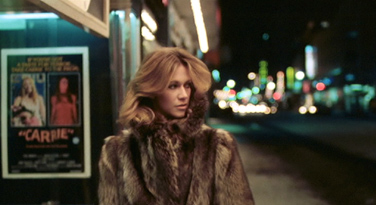
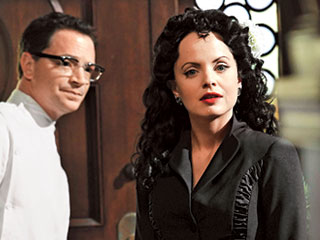 This week's episode of FX's American Horror Story, which aired last night, features Mena Suvari as "the Black Dahlia," aka Elizabeth Short. The episode is the second so far this season that was written by Jennifer Salt (also an executive producer on the show), and it ends with a bang: an unforgettable line of dialogue that seems to nastily set up the final leg of the season.
This week's episode of FX's American Horror Story, which aired last night, features Mena Suvari as "the Black Dahlia," aka Elizabeth Short. The episode is the second so far this season that was written by Jennifer Salt (also an executive producer on the show), and it ends with a bang: an unforgettable line of dialogue that seems to nastily set up the final leg of the season.

 Owen Williams interviewed Billy Drago for a UK film magazine, where it was trimmed down to fit the magazine's space constraints. But Williams has posted the full interview at
Owen Williams interviewed Billy Drago for a UK film magazine, where it was trimmed down to fit the magazine's space constraints. But Williams has posted the full interview at 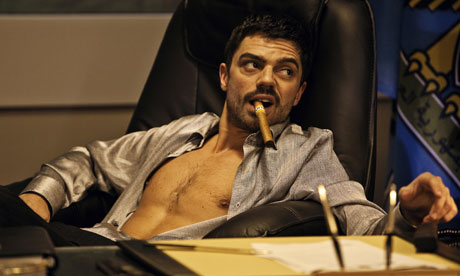 Lee Tamahori's The Devil's Double is based on the true story of Uday Hussein, Saddam Hussein's ruthless playboy son, and his body double. Dominic Cooper plays the dual roles of Uday and his double, and the film has been compared to Brian De Palma's Scarface ever since the first trailer was released. The film, dubbed everything from "the Iraqi Scarface," to "Scarface in Mesopotamia," has just been released on DVD, so it seems like a good time to post some links that touch on the comparisons.
Lee Tamahori's The Devil's Double is based on the true story of Uday Hussein, Saddam Hussein's ruthless playboy son, and his body double. Dominic Cooper plays the dual roles of Uday and his double, and the film has been compared to Brian De Palma's Scarface ever since the first trailer was released. The film, dubbed everything from "the Iraqi Scarface," to "Scarface in Mesopotamia," has just been released on DVD, so it seems like a good time to post some links that touch on the comparisons.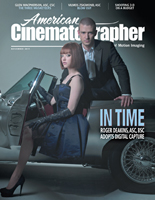 The November 2011 issue of
The November 2011 issue of 
